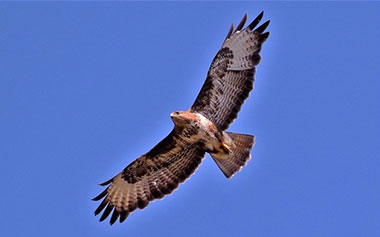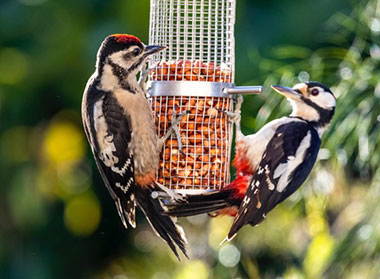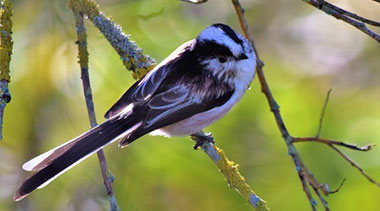
The Forest of Dean and the Wye Valley boast a wide variety of wildlife and we’re very proud that Puzzlewood can contribute to helping sustain so many different species, both on the ground and in the air.
Birds thrive in and around Puzzlewood where they can find plenty of food sources on which to live but, of course, you might not always spot them. So here’s a round-up of some of the birds you may be lucky enough to spot when you visit us next.
Buzzard

The UK’s most common bird of prey, a buzzard in flight is always an impressive sight as it glides and soars. Their call sounds rather like a cat. Buzzards can frequently be seen flying above Puzzlewood and are a year-round resident – small mammals and birds have to be on their guard when a buzzard is hungry!
Goshawk
Slightly smaller than a buzzard, the goshawk is one of the largest in the hawk family. Goshawks live in woodland and their hunting skills – at high speed and weaving in and out of trees – make them a phenomenal predator. They can be seen throughout the year, but a particular treat is their display flights high in the sky during late winter and early spring.
Peregrine
A large falcon that is fast and deadly when hunting its prey, the peregrine population has recovered since the 1960s when it dropped to very low numbers. Unfortunately, they are still subject to persecution. Peregrines will eat larger birds such as wading birds, ducks and pigeons, and unscrupulous individuals will illegally kill peregrines to protect game birds and racing pigeons. The peregrines can also be regularly spotted at nearby Symonds Yat Rock – nesting on the steep rock face.
Woodpecker

You’ll hear a woodpecker before you ever see one, they are very good at hiding themselves. Not surprisingly, woodland is the woodpecker’s favourite habitat, particularly mature broad-leaved trees. So Puzzlewood is simply perfect for them!
Flycatcher
Puzzlewood attracts both the pied flycatcher and spotted flycatcher. No prizes for how they got their name – these birds display fantastic aerial skills in catching moths, butterflies and other flying insects and are fascinating to watch. Look out for them during the summer months before they head towards West Africa where they spend the winter months.
Firecrest
A tiny and beautifully coloured bird, the firecrest displays a wonderful array of green, white, gold-bronze and black feathers. The yellow and black striped head makes them distinctive, and the males can be differentiated by the addition of a bright orange centre. Firecrests are making an appearance locally near the Speech House Hotel, and they are most likely to be seen during the autumn and winter months.
Great Grey Shrike
A winter visitor that returns to Scandinavia to breed, the great grey shrike can be hard to spot. They are extremely territorial birds so Puzzlewood would only ever be home to one or two at a time. As well as eating beetles and insects, shrikes prey on small mammals and birds and have a particularly gory habit of impaling their prey on sharp thorns. They perch high up in trees from where they can spot their prey, but smaller birds will also ‘mob’ a shrike to defend themselves.
Nuthatch

The nuthatch is easily mistaken for a small woodpecker, with blue-grey wings and upper body, chestnut belly and a black stripe on its head. Nuthatches breed in the UK and never venture far from where they hatched. It’s nice to think that Puzzlewood has supported generations of this lovely bird.
Cattle Egret
Cattle egrets are easily identified by their yellow legs and beak and will spend time close to livestock. They let the larger animals do their foraging job for them, finding insects and worms in the ground disturbed by cows’ hooves – clever! The numbers for this species are increasing in the local area around Puzzlewood, which is great news and you might be lucky enough to see one in the field surrounding us.
Blackcap
Part of the warbler family, blackcaps are also known as the ‘northern nightingale’ thanks to its lovely song. Not surprisingly, blackcaps are easily identifiable – males quite literally have a black cap, females a chestnut cap. Blackcaps tend to visit during the summer months, but are increasingly resident in the UK all year round.
Long-tailed tit

Common throughout the UK, the long-tailed tit is easy to identify by the length of its tail, which is bigger than its body. Long-tailed tits are quite noisy residents and tend to congregate in flocks of up to 20 birds.
Pied Flycatcher
Looking a little like a magpie but much smaller – smaller even than a house sparrow – the pied flycatcher is a summer visitor. Like other migrating birds, it spends the winter in West Africa. Puzzlewood and other wooded areas in Wales and England’s western regions provide an ideal breeding ground for the pied flycatcher, which is just one bird species under threat.
Owls

We also get a good number of night time visitors including owls – we’re not 100% sure which ones as it’s too dark to see! But we know Little Owls and Tawny Owls are present locally and they may just visit us too. If you stay with us in our onsite holiday cottages you may just sneak a glance of our night time visitors!
Waxwing
A plump and distinctive looking bird, the waxwing has a very prominent crest and looks like it’s wearing a black mask. It also has yellow tips to its wings and tail. Waxwings visit the UK during the winter.
Robin

Last but definitely not least, the robin must be one of our most loved birds. Easily identified by its red breast, robins are renowned for their curiosity and lack of fear around humans. However, when it comes to other birds the robin is very territorial and will behave aggressively to keep them away. Robins are one of our most photographed birds at Puzzlewood, perhaps because they sit still long enough to be captured on camera.
Next time you visit, don’t forget to keep a look out for our feathered friends. And if you’re a keen-eyed twitcher and happen to spot a species of bird we haven’t mentioned, do let us know – it might just be a rarity in the area!







